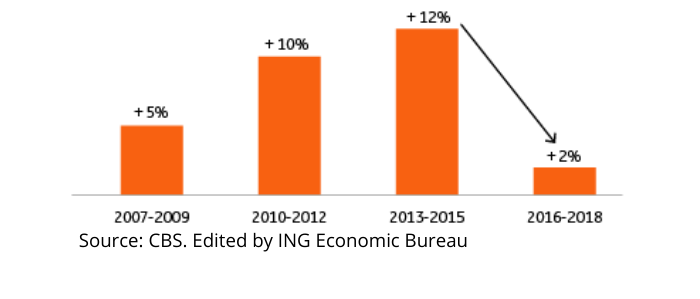According to a study conducted by the ING bank, in terms of digital transformation, the construction industry gained considerable ground between 2010 and 2015. The reason for this is that internet became mobile during this period. And this is essential for the construction industry, as construction professionals working on different projects are always on the move.
However, despite the significant growth during those five years, there has been a decrease since then. The value of software and databases in the industry has grown less rapidly and there has also been a decline in investments in ICT. This is mainly due to the fact that the major benefits of mobile internet were being utilised at that time, the necessity seemed to have disappeared and the next step in digitalization was more complex. 
Average annual growth value of software & data per employee in the construction industry
What may also play a role after 2015 is that the industry started to emerge from the repercussions of the financial crisis. Production increased significantly following an enormous dip. And when things are going well, why go in search of new solutions? One reason to do so is to remain one step ahead of your competition in difficult times. Ensure you have already mastered digital solutions when your competitors are only just starting to discover their potential.
Advantages of digitalization
Digitalization has many advantages over traditional construction:
Efficiency increases
This is mainly because the information provision to various departments is greatly improved. This averts errors and therefore additional costs. Managing separate information flows to colleagues and subcontractors is automated with digital solutions, so that all parties involved are constantly aware of the latest changes.
Digitalization provides insight into data
Companies make better strategic decisions with data-based facts provided by digitalization. It improves the analysis and adaptation of processes. Where are the sales opportunities? Which often submit quotes? What is the financial health of our partners?
Digital companies are more productive
Digital companies have an average higher labour productivity (turnover divided by the number of employees) than non-digital companies.
Digital solutions are safer
You can have a filing cabinet perfectly organised by date and time, but what if something happens to it or to the documents inside? Whether it is a fire, a burglar or just an accident with a cup of coffee, relying on a single copy of all your important documents is not recommended. You should always have a digital backup of everything. The cloud provides a simple, secure way to save and share your documents.
Digitalization provides significant help to construction companies in complying with the Quality Assurance Act, which is likely to be introduced in the course of 2022. The new law aims to improve construction quality and supervision. To this end, construction companies must document the construction process in a structured manner. Digitalization reduces the increasing administrative burden.
Achieving success with digitalization
Digitalization involves making acute strategic choices to take advantage of the opportunities that are available. There is no single path to success. There are various options and you decide what works best for your company.
Option 1. Develop digitalization yourself
Various construction companies have developed their own digital platform. The advantage of this is that you have bespoke software, specifically for your own company. The disadvantage, however, is that the costs of developing in-house are much higher and it can be difficult to recruit well-qualified personnel to do this.
Option 2. Continue to build traditionally
Construction companies sometimes choose to continue to build traditionally and not to utilise the advantages that digitalization offers. These companies can focus on niches where personal contact, customisation and less standardisation are required. For this option, it is important to take into account that everyone else, including the construction industry, will continue to digitalise and will surpass the non-digital companies.
12Build believes that the traditional, personal contact that the construction industry is founded on does not need to disappear with digitalization. That is why we give you the opportunity to add your own logo and company information to templates for tenders. In this way you can digitalise your tender process while continuing to provide the personal touch of your company. 12Build offers an opportunity to save time in the tender process, but is not intended to replace personal contact. As far as we are concerned, these two aspects of collaboration go hand in hand.
Option 3. Purchasing digitalization
Construction companies can also purchase software in order to digitalise. The advantage of this is that the costs are often relatively limited and that construction companies do not need to have the tools developed themselves.
12Build is the leading platform for the construction industry to facilitate collaboration between the subcontractor, supplier and general contractor. General contractors can search and find subcontractors who meet the requirements for a project in the extensive database of 12Build. And we have made the whole process easy through the use of multiple filters, such as specialisation, quality labels, certificates and distance to the construction project. When an invitation to tender is submitted, all documentation is sent to the subcontractor through 12Build, without a limit to the number of documents. No more hassle with multiple e-mails and WeTransfer uploads.
When a subcontractor indicates the intention to submit a tender, you will see this immediately at a glance. And that will save you valuable time that you can best spend on other useful things.
New digital solutions usually supersede their older counterparts. And once these solutions are in place, the implementation is much easier if you are already up to date. Compare the easy transition you made from your local hard drive on your computer to Google Drive, OneDrive, Dropbox or another cloud solution. In the earlier situation, it was a problem if you had to work somewhere else than your own office. Now you can simply access the cloud and all your files are up to date. The same applies to digitalising your tender process. If you neglect to do this now, you will only make it more difficult for yourself in the future and perhaps there will no longer be an easy or inexpensive way to bridge the gap between your working method and digital innovation.




